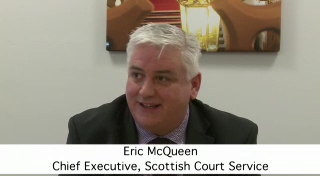1.1 An overview of the court structure in Scotland
In this section you consider the court structure. Before exploring each of the courts and their role you should watch the following video.
In this video Eric McQueen, Head of the Scottish Courts Service, gives an overview of the court structure in Scotland.
Download this video clip.Video player: The criminal justice system (Eric McQueen, Scottish Court Service)


Transcript: The criminal justice system (Eric McQueen, Scottish Court Service)
ERIC MCQUEEN
: Good morning, I'm Eric McQueen. I'm Chief Executive of the Scottish Court Service, and my primary role is to set the direction for the Court Service and provide leadership to the staff that work within the Court Service. The court structure works in very much a pyramid-type structure. At the top, we have the Supreme Courts, which contains the High Court of Justiciary and the Court of Session, the High Court dealing with criminal business, the Court of Session dealing with civil business. We then have a range of six sheriffdoms across Scotland where we have both Sheriff and JP Courts located within them.
In terms of specifically on criminal business, we've got four different types of courts in Scotland that can hear criminal cases, and the Procurator Fiscal makes decisions on where those cases will be prosecuted. The High Court deals with the most serious cases in Scotland, and that includes cases like rape and murder, for example. And In all High Court cases, decisions and verdicts are made by a jury. There's no limits on the length of prison service that can be imposed by the High Court, and equally there's no limits on financial penalties that can be put in place.
Within the Sheriff Courts, we have two different procedures, one called solemn procedure with cases are decided by a jury and one called summary procedure where cases are decided by the Sheriff sitting alone. In solemn procedure, which is the more serious type kind that comes in Sheriff Courts, the court can impose a period on the accused of up to five years imprisonment and can impose any amount of fine. In summary procedure, the courts can impose a prison service up to a year, with a maximum fine value of 10,000 pound.
Supporting that, we also have what we call Justice of the Peace Courts, and these are administered by the Justices who are members of the judiciary without a legal background. They're drawn from the community and have a wide range of background and experiences and a wide range of ages. Justices of the Peace can serve sentences on accused of up to 60 days imprisonment and fines up to a maximum value of 1,000 pound.
The criminal justice system (Eric McQueen, Scottish Court Service)
Interactive feature not available in single page view (see it in standard view).
